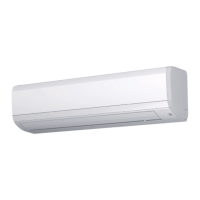9. Leak test all refrigerant piping connections,
including the service port flare caps, to be sure they
are leak tight. Do not over-tighten (between 40 in.
lb and 60 in. lb maximum).
NOTICE
Line set and indoor coil can be pressurized
to 250 psig with dry nitrogen and leak tested
with a bubble type leak detector. Then release
the nitrogen charge. Do not use the system
refrigerant in the outdoor unit to purge or leak
test.
10. Evacuate the vapor line, indoor coil, and liquid line
to 500 microns or less.
11. Replace cap on service ports. Do not remove the
flare caps from the service ports except when
necessary for servicing the system.
CAUTION
Do not connect manifold gauges unless
trouble is suspected. Approximately 3/4 oz
of refrigerant is lost each time a standard
manifold gauge is connected.
12. Release the refrigerant charge into the system
by opening the liquid line valve first. After a few
minutes, the suction line valve may be opened.
Open both the liquid and vapor valves by removing
the plunger cap and with an hex wrench, back out
counterclockwise until the valve stem just touches
the chamfered retaining wall. If the service valve
is a ball valve, use a adjustable wrench to turn the
valve stem 1/4 turn counterclockwise to open.
Do not overturn or the valve stem may break or
become damaged. See Precautions during brazing
of service valve.
13. Replace the plunger cap finger tight, then tighten
an additional 1/12 turn (1/2 hex flat). The cap must
be replaced to prevent leaks.
WARNING
Never attempt to repair any brazed
connections while the system is under
pressure. Personal injury could result.
See System charge for checking and recording
system charge.
Coil metering devices
CAUTION
COIL UNDER PRESSURE. Verify that pressure has
been released by depressing the Schrader valve
core. The coil requires a metering device to be added.
Refer to the outdoor unit documentation for the correct
TXV or piston to be used.
NOTICE
To prevent moisture and contaminates from entering
the system, the coil must not be open to atmosphere
for extended periods of time. If the coil cannot be
brazed into the refrigeration system during a routine
installation period, the ends must be temporarily
closed or plugged. For a short term delay, use
masking tape over the ends of the copper tubing to
close the tube from the air. For a longer term delay,
use plugs or caps. There is no need to purge the coil if
this procedure is followed.
Installing a thermostatic expansion
valve (TXV)
CAUTION
Outdoor unit model numbers ending with an H have a
factory installed hard start kit which is required when a
TXV kit is installed. Outdoor unit model numbers with
no H ending do not require a hard start kit unless local
regulations dictate it.
The following are basic steps for installing a TXV kit. For
detailed instructions, refer to the Installation Manual
provided with the TXV kit.
Important: Refer to the Technical Guide or Tabular
Data Sheet for the unit to determine the correct TXV
kit to use on this product.
1. Relieve the holding charge by depressing the
Schrader valve core on the suction manifold stub
out.
Installation Manual: R-410A Outdoor Split-System Air Conditioner 11
Johnson Controls Ducted Systems

